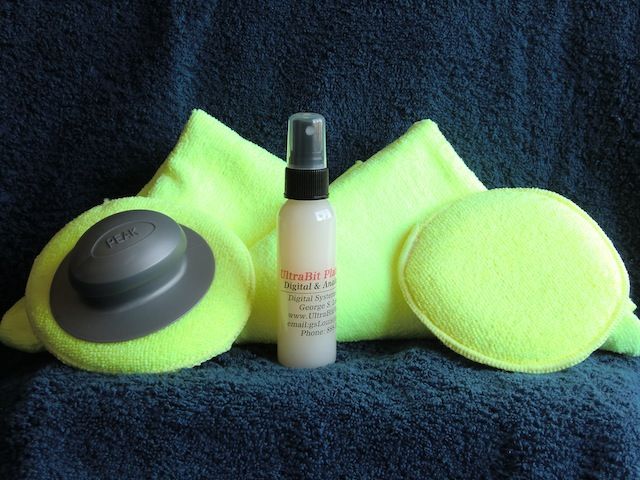I don't at the moment have anything interesting to say about Ebola, Obama the Failed Messiah, the Islamic State, Boko Haram, or Mexican drug gangs. Those sorts of things tend to bring me down. On to pleasanter matters.
We speak now of sacred mysteries: namely, the magic of cost-effective treatments that make recorded sound more lifelike. Some are a royal road to sonic improvement.
Audiophiles, God bless 'em, will spend astonishing amounts of money on equipment upgrades. No criticism. If I had the kind of dough to buy $30,000 speaker sets, $10,000 preamps, $15,000 power amps, $8,000 DACs, etc., I might. Still, as the poet said, "I, being poor, have only my dreams."
Fortunately, we plebs can still magnify our listening pleasure with relatively inexpensive tweaks.
To get to the point, it is a product called Ultrabit Platinum-Plus (UBP-P). Its slogan is, "Hear the music, not just notes." For once, truth in advertising.
The photo shows what you get: a bottle of fluid, two microfiber pads and two microfiber cloths, and a handle that grips the pads. The lime green color of the pads and cloths shown here must be a previous model or Photoshopped; those that I received are yellow. This is not a step forward. Yellow should be, if not outright banned from the world, at least subject to strict licensing. Green, blue, almost anything except brown would be aesthetically far more pleasing.
Application of UBP-P is easy-peasy. One squirt onto the disc playing surface. A few swipes of the pad or cloth and the fluid seems to evaporate -- it's fun to watch it disappear -- but leaves a residue that somehow enhances the sound of the recording. The manufacturer says it works equally well on CDs or analog vinyl records. I'm a CD loyalist, unfollowing the fad, er, excuse me, the current taste among the cool heads for black discs, so I can only testify about UBP-P's canonization of silver discs.
I sympathize with the equipment reviewers for audiophile magazines who must continually struggle to find new ways of describing the sonic qualities of high-end components that cost a kidney. They fall into esoteric language that I often fail to understand: "The hue, attack, and extension of each note must be allowed to develop completely but not excessively," etc. Perhaps my listening ability has not developed completely. Or maybe it's excessive.
Anyway, trying to explain what treatment with UBP-P does is something of an exercise in frustration. The word I use constantly for the quality of an exceptionally good recording (whether tweaked or not) is simply, "presence." The music is in your listening space, lifelike. No doubt there are more sophisticated, scientific, or literary ways of putting it, but for me that's basically what it comes down to.
I've dosed about a hundred CDs with this product, and in about 90 cases I noticed more presence, often a lot more. Subjective? Sure, you can do all sorts of analytical lab work on a recording, but listening is nothing but subjective. Placebo effect? Maybe with a handful of discs, but I just can't write off the increased realism I perceive again and again.
Mind you, this tweak -- like equipment upgrades -- can't make bad recordings sound good. But for any CD recorded with decent microphone placement and mixing, the reward is palpable. And I don't think you have to have a state-of-the-art sound system to appreciate it (mine is satisfying, but hardly high-end). I am sometimes surprised at how striking a CD sounds in my car, which has a player and speakers courtesy of the original equipment manufacturer, and then I remember I gave that disc a squirt and wipe of UBP-P.
UBP-P appears to be the invention of George S. Lewis, who markets the stuff. For you suspicious minds, I do not know Mr. Lewis from Adam and vice versa, and I paid for the kit. Anyway, I take my hat off to him, or would if I liked wearing hats.






4 comments:
I could see the point with vinyl, but for CD's the only thing that would make sense is because the disc is cleaner, the DAC doesn't have to rely on error correction so much. Otherwise it's the same 0's and 1's that make up any .wav file.
As an experiment, 'rip' a typical CD to a folder of .wav files, do the treatment, then rip again to another folder.
Then you can compare 'disc-before' to 'disc-after' either by playing tracks from the two folders or use a program such as windiff.exe to do a bit-by-bit comparison.
Of course, it could be like those who swear tube amplifiers have superior sound to solid-state ones.
YIH,
The UBP-P solution is not a cleaner. It somehow enhances the reflectivity of the playing surface. No tweak changes the 0's and 1's of the digital data, but a laser beam has to read those data and a chipset has to interpret them.
Both smoothing the CD surface (for which I still use Mikro-Smooth, remarkable for its cost-effectiveness) and various surface coatings including UPB-P reduce the "jitter" that the laser and electronics have to compensate for. That's my take, anyway, but I'm no technical expert; still I maintain I can hear the improvement.
Apparently you know about flying than I do.
A car that can take flight even if it's useless as either a car or a small plane.
There are those who want to sell us a car that can take flight.
Why do I say that?
Google claims it can produce an 'autopilot' car.
In San Fran that actually might be possible.
Can Google even find the right exit from I-95?
YIH,
A flying car might be useful if a cop is trying to pull you over. However, if you are caught and charged the judge won't allow bail: you'll be considered a "flight risk."
Post a Comment